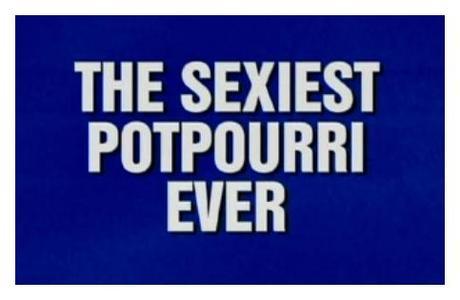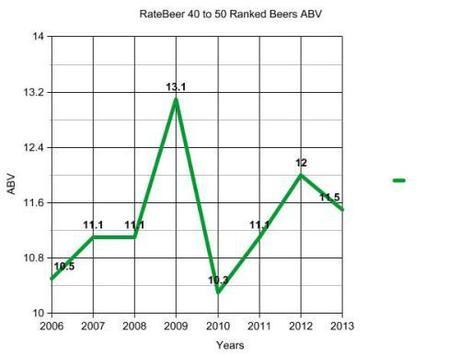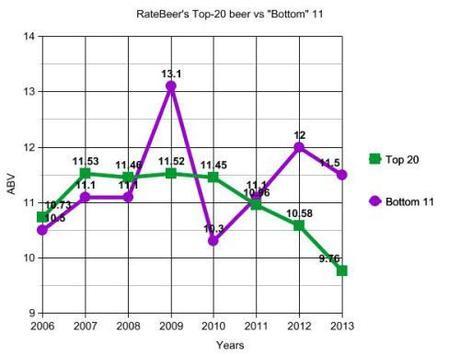
Before we wrap up this series on RateBeer’s “best beer” rankings, be sure to check out previous posts on declining ABV and geography of top beers.
Today is a bit of a hodge-podge collection of bits from my look into people’s beer preferences and appreciation via RateBeer.com. I suppose it would fall into the “Potpourri” category on Jeopardy.
As explained in part one, I looked into the top-20 rated beers from 2006 to 2013 because I felt keeping solely to the top 10 wouldn’t produce enough variety to show significant differences from year-to-year. However, I assumed that the bottom of each list wouldn’t suffer from any such drawbacks.
Essentially, if there’s going to be a group that would show volatility of beer brands, I’d expect it to be at the bottom of the list, where beers may come-and-go more freely thanks to new entries into the beer market and less of a group conclusion on how epic a particular beer really is.
While imperial stouts still fill up the ranks – they dominate throughout each list – looking at the “bottom” beers showed me some funny behavior of RateBeer’s users.
To show the volatility of the “bottom” of the best beer list – this includes beers ranked 40th to 50th – here’s a look at average ABV per year (and here’s the list of beers):

… and for posterity’s sake, here’s the bottom 11 beers vs. the top 20:

Whereas the top 20 beers of these lists show a clear trend downward in ABV, the bottom group stays consistent in its higher strength.*To note: I realize it’s not apples-to-apples with top 20 and bottom 11, but the bottom 11 was an easy way to stress my point that outside the top 20, each RateBeer list typically stays true to higher-ABV beers and a lower variety of styles.
This is to say the Berliner Weisses and saisons that appear at the top half of the RateBeer lists in the last couple years are given up for more traditional “best of” list beers at the bottom, like barleywines, imperial stouts, Belgian or American strong ales, etc.
What I inferred from looking at the “bottom” ranked beers reinforced my thoughts on the top-rated beers: in an ever-saturating marketplace, breweries must adapt and innovate in order to perform well. Beer drinkers are becoming more interested in drinking high-quality beer based on taste (and a little bit of hype) no matter the ABV. This is shown through a wider and new variety of beers at the top of each RateBeer list and consistent showing of malty, high-ABV beers at the bottom.
In the earlier years of RateBeer’s rankings, it seemed hype, style and strength all worked together to create a top-flight beer. Now strength doesn’t seem to matter as much.
What makes me most curious about looking at these graphs? I want to know why we were all so boozy in 2009, when average ABVs for the top and bottom were historically high for the lists.
————–
Now, aside from all this, here are a few fun observations about the rankings after I looked at both the top and bottom of each year on RateBeer.com’s rankings:
1. In 2006, Rochefort Trappiste 8, a Belgian dark strong ale, was highly regarded at 17th, then tumbled to 42nd in 2007.
2. Aside from Pliny (the Elder or the Younger), Russian River has had a hard time cracking RateBeer’s lists for their other offerings. Supplication, a wild ale, first appeared at 41st in 2008 and shot up to 20th in 2011.
3. I pointed out on Wednesday the increase of breweries and how the increasing variety of beers has had a tremendous impact on these rankings. Consider this: Dogfish Head, one of the most popular craft breweries of the last 20 years, has had World Wide Stout tumble as more imperial stouts and other varieties have caught the eye of beer lovers. It was…
12th in 2006
16th in 2007
48th in 2008
… and then it was gone.
4. For years, Great Divide has been a consistent love for beer drinkers. Especially their Oak Aged Yeti Imperial Stout. It’s hard to get rid of it from RateBeer’s rankings:
14th in 2006
49th in 2010
43rd in 2013
This goes to show how highly people think of this particular beer. As World Wide Stout has fallen, Great Divide’s large distribution area and overall quality certainly help keeps Oak Aged Yeti afloat.
5. Dieu du Ciel’s Péché Mortel, an imperial stout from Montrael, has apparently captivated French-speaking beer drinkers. Or just ones that love good beer. It shot up from 50th in 2008 to 20th in 2010.
————–
… and there you have it. (Hopefully) a fun look into the structure and history of our favorite beers, according to RateBeer. Are there any observations that strike you? What does all this leave you wondering about?
Thanks for playing along.
+Bryan Roth
“Don’t drink to get drunk. Drink to enjoy life.” — Jack Kerouac

